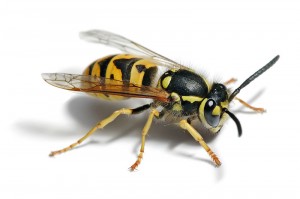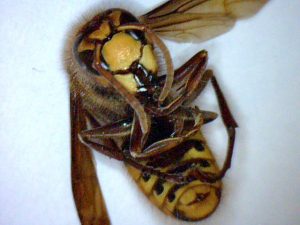Wasp Problems in January
In Pests
 As the Winter progresses wasp problems get fewer but are still there. At PEST UK we get less calls about wasp problems in January than in December. This is because by January the Queen Wasps (& Queen Hornets) are in ‘proper’ hibernation. The fertile Queens of both wasps and hornets are the only forms to survive the Winter. No nests function in the Winter. They have all died out, cannot be re used and these Queen Wasps and Hornets all attempt to make new nests in the Spring. They can cause problems in houses when they are disturbed by fluctuations in artificial heat and light. Although lofts provide a safe easy place to hibernate they are susceptible to artificial light and heat which can ‘fool’ the Queen wasps or Hornets to come out of hibernation. In most cases most reported problems of wasps and hornets in January are actually Queen Wasps but many people think they are hornets due to their size.
As the Winter progresses wasp problems get fewer but are still there. At PEST UK we get less calls about wasp problems in January than in December. This is because by January the Queen Wasps (& Queen Hornets) are in ‘proper’ hibernation. The fertile Queens of both wasps and hornets are the only forms to survive the Winter. No nests function in the Winter. They have all died out, cannot be re used and these Queen Wasps and Hornets all attempt to make new nests in the Spring. They can cause problems in houses when they are disturbed by fluctuations in artificial heat and light. Although lofts provide a safe easy place to hibernate they are susceptible to artificial light and heat which can ‘fool’ the Queen wasps or Hornets to come out of hibernation. In most cases most reported problems of wasps and hornets in January are actually Queen Wasps but many people think they are hornets due to their size.
Treatment
 If Queen Wasps and Hornets are causing problems then it is possible to treat either by using an insecticide ‘fog’ in the loft and/or a residual insecticide spray to walls and ceilings. Treatments such as these will not eliminate the problem but certainly reduce it. An insecticide ‘Fog’ is applied to large voids such as lofts using a Fogging machine. This is similar to using a massive can of fly spray. The disadvantage of this compared to surface spraying is that it is not very residual but for a residual insecticide surface spray to work the surfaces have to be generally smooth, clean and dust free, not the types of conditions you get in a loft. Any wasps that crawl over the surfaces treated with the residual insecticide spray or come into contact with the insecticide fog will absorb the insecticide and die but due to the Queen Wasps having a slow metabolism at this time of year this may take some time.
If Queen Wasps and Hornets are causing problems then it is possible to treat either by using an insecticide ‘fog’ in the loft and/or a residual insecticide spray to walls and ceilings. Treatments such as these will not eliminate the problem but certainly reduce it. An insecticide ‘Fog’ is applied to large voids such as lofts using a Fogging machine. This is similar to using a massive can of fly spray. The disadvantage of this compared to surface spraying is that it is not very residual but for a residual insecticide surface spray to work the surfaces have to be generally smooth, clean and dust free, not the types of conditions you get in a loft. Any wasps that crawl over the surfaces treated with the residual insecticide spray or come into contact with the insecticide fog will absorb the insecticide and die but due to the Queen Wasps having a slow metabolism at this time of year this may take some time.

